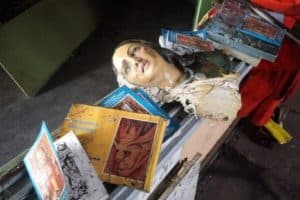Arson and vandalism: targeting churches in Santiago, Chile
THE FOLLOWING is a translation of an article published Oct. 20, 2020 in El Mercurio, daily newspaper in Santiago, Chile
The embers are still smouldering, and you can smell the smoke in the centrally located Church of the Assumption in the Chilean capital, Santiago. Looking up from the floor of the central nave, one can see the cloudy sky above, for the roof has been totally destroyed. So has the central spire of the church, once a landmark characterizing this part of the city. When the tower collapsed, the two bells fell from high up in the belltower. One of them was shattered, while the other was salvaged from the ruins. The benches and altars had already been burned and smashed earlier, during the protests of the previous year. Following those attacks in 2019, the doors and windows had been boarded up, but this was not enough.

The church had continued to suffer throughout 2020 from continuing threats and graffiti. “Owing to its situation, just a few feet from the Plaza Baquedano [a central landmark and focus of recent protests], the parish had been living through a state of constant insecurity, even during the coronavirus lockdown. Ever since 2019 the walls have been covered with graffiti, both inside and out, with slogans attacking the Church and priests and such phrases as ‘Let’s see it burn down’,” explains María de los Ángeles Covarrubias, the president of the Chilean office of the pontifical Aid to the Church in Need (ACN), which helps Christians around the world who are persecuted or threatened in their faith or otherwise in grave need.
“To see the deliberate burning down of a church destroys your soul,” Mrs. Covarrubias continues. “It reveals the degree of brokenness of our society, in which small groups of people come to regard themselves as the only ones in the right and thereby entitled to destroy and even celebrate the destruction of buildings that represent the faith of a community. The irrationality and hatred that we are witnessing is an attack on a fundamental human right to religious liberty. Such violence should have no place in a society that claims to be democratic.”
Father Pedro Narbona, the parish priest, tells how he still shudders at the “euphoric celebrations when the church spire fell last Sunday. It reminded me of November 2019, when they decapitated the statue of Our Lady, which had stood outside the west front of the church. It hurts me that the community has now been left with no place to gather, now that a small hall that we were using has been completely vandalized.
“Here in this church is contained a living history that goes well beyond its own walls. It is that relationship with God of those many people who came here to pray, to baptize their children, to marry, and to say farewell to their departed loved ones.”
Magdalena Lira, the national director of ACN Chile, reveals that “ever since the first attack and vandalism on November 8, 2019 we have been getting together with the parish priest Father Pedro Narbona to raise funds for the restoration of the church. We were just at the stage of refining the project, together with a team of professionals. On November 8, the anniversary of the first attack on the church, Father Pedro was going to announce the start of the restoration work. Now our plans have been torn to shreds.”
“The Catholic faithful need a worthy place to meet God, celebrate the sacraments and gather together. It is not simply a matter of a physical structure which may in some cases have value as part of the national patrimony, but rather of a building that is a custodian of the history of a community,” says Maria Covarrubias. Following the earthquake of 2010, ACN Chile has managed to build 45 emergency chapels and it has also restored nine churches damaged by the earthquakes of 2005 and 2010. “But until just a few years ago we never imagined that we would see churches in Chile burning as a result of intolerance,” she adds.
For Pablo Allard, the chief architect of the local administration, the Church of the Assumption holds a personal significance. His own mother, Angélica Serrano, had donated to the church a painting she herself had painted. “I believe that, beyond our creed or denomination, churches are works that speak of the power of the mystery of faith and the search of humanity for a transcendence that goes beyond the material,” he says. “They are essentially places of community, which not only provide service by bringing the liturgy of the word to believers, but are also centers of aid and support for the most vulnerable, and at the same time part of our tangible and intangible patrimony. Even though our resources are limited, I believe that the reconstruction of these churches should be undertaken as a work of reparation and of commitment to social peace.” Such is the view of this architect and urban planner.
Noted photographer and documentary maker Pablo Valenzuela Vaillant has made it his business to photograph the arson attacks of last Sunday, and yesterday he visited the ruins of the two churches and was deeply affected. “Right from the start of the estallido social [“social outbreak” – the term used by the Chilean media to describe the eruption of violent protest], I began documenting the events photographically, concentrating on the Plaza Italia and the surrounding area. A sort of urban record of the sector, taken on different dates,” he explains. “Seeing and photographing these two churches burning now moves me to make an appeal across all levels of society, without any political distinction of any kind, to unite together and safeguard our natural and cultural patrimony, for the good both of present and of future generations.”

